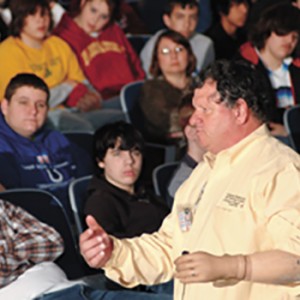
Chuck Tiemann talks to a group of students at Kankakee Valley High School in Wheatfield about electrical safety. The senior risk management/regulatory consultant for the Indiana Statewide Association of RECs has dedicated his life to keeping linemen and consumers safe. A former lineman, Tiemann lost his left hand and right leg in an electrical accident 27 years ago. Photos by Richard G. Biever
How do you get high school students to pay attention to a show and tell on electrical safety — stuff they’ve heard a million times before?
For starters, you might unsnap your left hand at the wrist and pass it around. Or hold up one of your spare right legs. Or tell them what it’s like to have 7,200 volts of electricity pass through your body and leave you dead and dangling backwards, head against your heels, from the top of an electric pole.
When Chuck Tiemann talks about electrical safety, people of all ages listen. That’s because the safety and loss control staff member at Indiana’s electric cooperative association personally knows all about electrical safety … and loss. He can show and tell.
And he does.
As a 24-year-old electric cooperative lineman in his native Oklahoma, Tiemann lost his left arm below the elbow and his right leg below the knee after making contact with a live power line. The accident 27 years ago momentarily took his life, and changed it forever.
When he speaks, he brings a message of electrical safety, debunks electrical myths, and leaves listeners of all ages and backgrounds with a keener respect for electricity and the precious gift of life.
Tiemann, who came to Indiana last year after spending most of his career in Oklahoma and Alabama, travels the state for the Indianapolis-based REC association working with linemen and co-ops to prevent accidents like his. Last month, Jasper County REMC brought him in to high schools in Wheatfield and Rensselaer to speak to students.
Tiemann (pronounced “tee-man”) opened his talks remembering back to that day, May Day — May 1, 1980.
After a long month repairing storm damage, he and fellow linemen were working on routine line construction in open range country. He was told the power had been cut to a section of line he was to work on. He climbed the pole. Instead of slipping on his rubber gloves as a precaution, he reached for the line with his left hand protected by only a leather glove.
The line was not dead. In an instant, 7,200 volts of electricity entered his fingers, went through his body, stopped his heart and blew a hole out the big toe of his right foot. The electricity sought the quickest path from his hand to the ground and found the neutral wire near where he’d planted his right boot.
“It burned the tips of these two fingers off,” he told the students, using his right hand to touch the fingers of a prosthetic left hand he now uses. “That’s what cleared me from the line — and saved me.”
He said he slumped backward on the pole. A lineman quickly scampered up and gave him two quick breaths of air. Tiemann regained consciousness and recalled being lowered to the ground. The crew placed him in a truck, called for help and raced to meet an ambulance at an accessible location. “It was not a good day at work at all,” he told the students.
 He spent the next 10 weeks in a Tulsa burn unit after undergoing the two amputations and five major surgeries.
He spent the next 10 weeks in a Tulsa burn unit after undergoing the two amputations and five major surgeries.
He credited his strong-willed wife, Terri, his high-school sweetheart who was just 24 years old herself at the time, for pushing him to regain his independence. They turned the challenges they faced into opportunities.
“I don’t know why my life was spared. But I’m thankful for it,” he said. “I take not one day for granted. Not one breath of life do I take for granted because life is precious, and it could be gone that quick. And I understand that.”
After his recovery, he began counseling other electrical burn victims: linemen from all over the country and children who’d been burned climbing trees. Then he returned to the electric cooperative family. “I got tired of counseling with people that had been burned; I decided one day it was time to make it stop,” he said. “That’s why I’m doing what I’m doing. I’m trying to make people a little more smarter about electricity … I’m trying to make a difference.”
Power lines, he said, are designed to deliver power to homes and businesses efficiently. “Electricity has no conscience. It has no way to know if you’re a microwave oven coming on, or a person that’s made contact. It can’t determine that.”
He then began to dispel dangerous myths people have about power lines. Just two of the facts he gave are:
- Overhead power lines are bare wire. He said most people think those lines atop poles are insulated like the cords attached to appliances. This is not so.
- Downed power lines are not necessarily dead power lines. When an automobile accident or weather breaks an electric pole or knocks a line down, the power line could still be energized and be dangerous.
He warned students to always be aware of power lines. He said to look up before raising that grain auger or flying kites. And he said trees and power lines do not mix. He then told a sad but true story that brought tears to the eyes of some. He said it’s hard for him to tell it. But he does to emphasize the need to be safety minded. (Please note: the following paragraphs describe a story a child’s death.)
“A few years ago down in another state,” he began, “this little 7-year-old girl started climbing this tree out there on her lawn, having a good time. Mom and Dad were out there with her. But she goes a little too high. She reaches up. She grabs this power line. And she starts screaming.
“She’s screaming … She can’t let go, she can’t let go. So what do you think her dad does? He climbs the tree to get her down. She’s getting shocked …. He starts getting shocked. She’s now part of the circuit of that power line. Daddy gets up there, but he can’t get to her. He can’t get his own daughter out of that tree.”
Tiemann said neighbors called 9-1-1. The firefighters and police came, but they couldn’t touch the child either. The electric co-op was then called, but by this time it was much too late to save her. “The co-op immediately drops what they’re doing,” Tiemann said. “They send two crews. One goes to the breaker to open up the line.”
The other, he said, went to the home where the girl was still caught on the power line in the tree. A lineman raised himself in a bucket to the girl.
“He gets up there and he starts getting this beautiful, innocent, little girl down,” Tiemann continued. “He starts taking those little bitty fingers off that power line. And every time he takes a finger, it breaks off in his hands … ,”
The lineman collects the shattered fingers and scrapes the skin from the line and places it in a bag, Tiemann noted, because, “He wants that beautiful baby buried with all that God gave her.…
“I don’t want our linemen to go through that. I don’t want you to go through that. I don’t want your family, I don’t want the community, to have to go through that.”
He said that lineman is still haunted by the memory of removing the girl and her fragile fingers from that wire.
“That’s why I want you to understand electricity,” he told the students, “and how our systems work and why they work the way they do.” — Story by Richard G. Biever, senior editor



